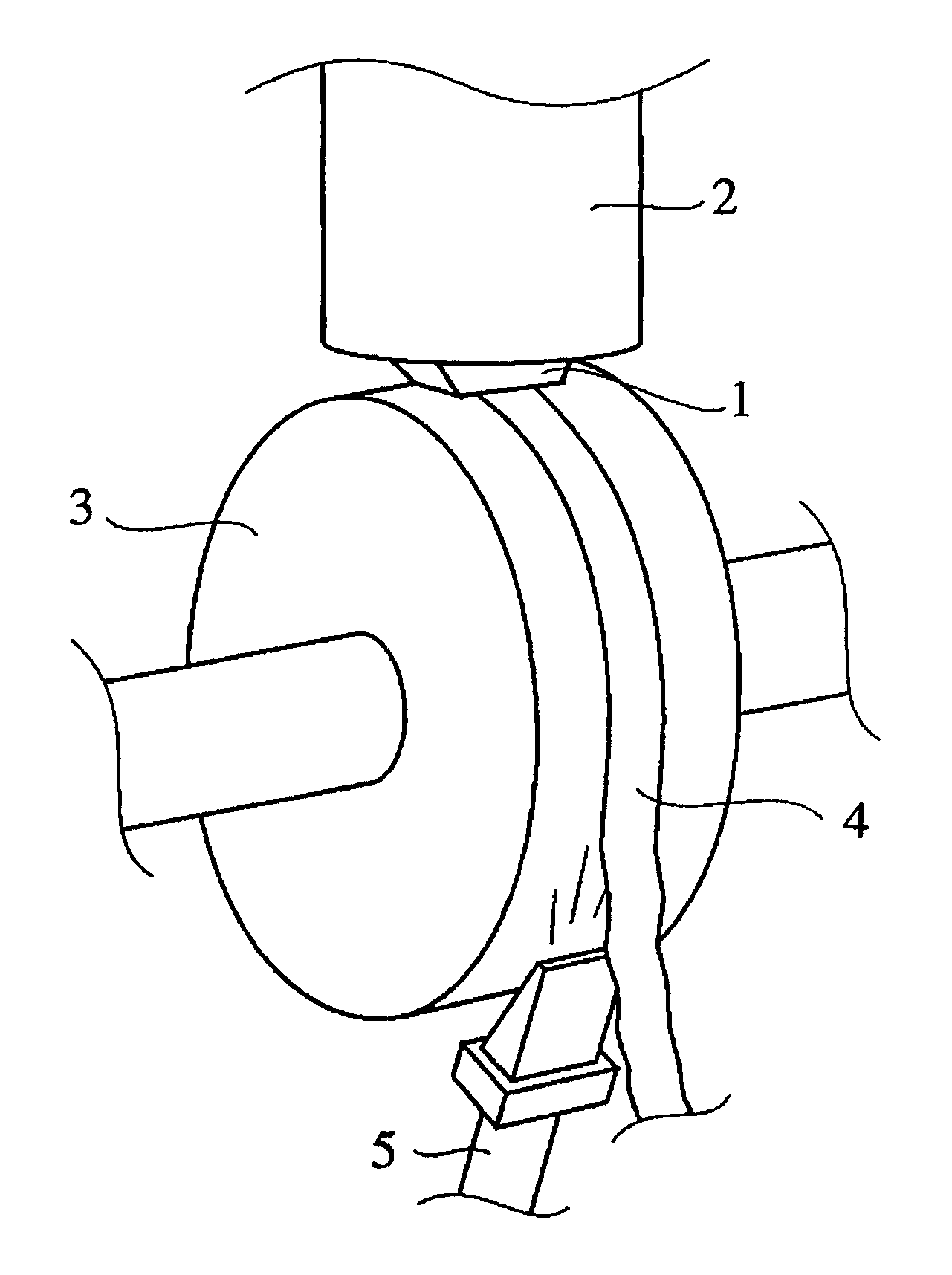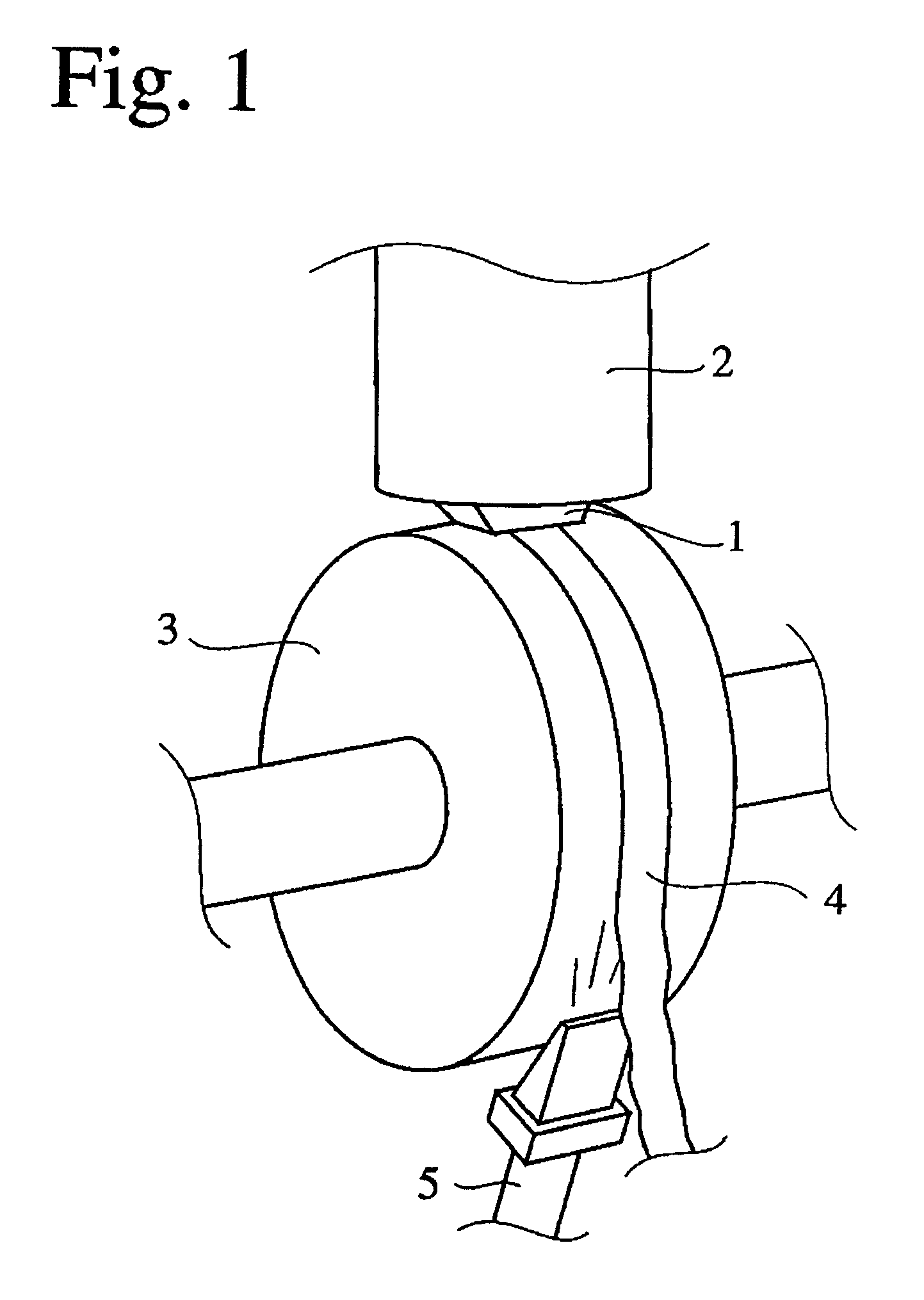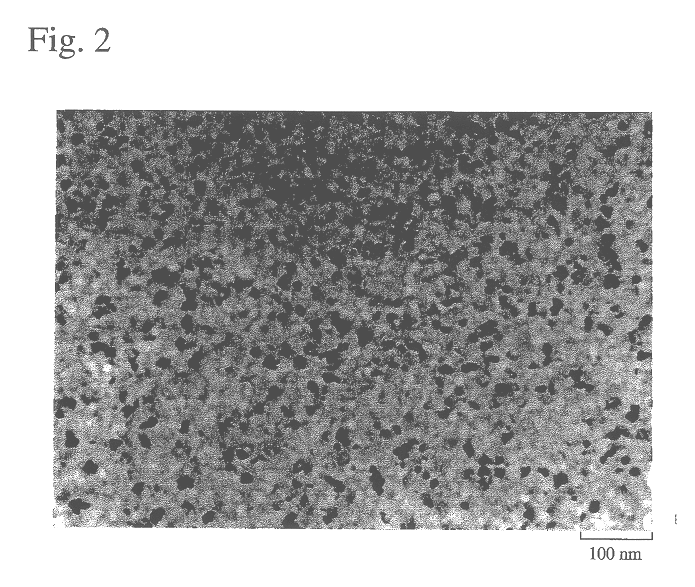Methods for producing iron-based amorphous alloy ribbon and nanocrystalline material
a technology of nanocrystalline materials and amorphous alloys, applied in the direction of magnetic materials, magnetic bodies, electrical equipment, etc., can solve the problems of difficult continuous production of cores, poor soft magnetic properties, and inability to continuously obtain ribbons, and achieve excellent soft magnetic properties
- Summary
- Abstract
- Description
- Claims
- Application Information
AI Technical Summary
Benefits of technology
Problems solved by technology
Method used
Image
Examples
example 2
A Fe-based amorphous alloy ribbon of Sample No. 6 having a composition of Cu.sub.1 Mo.sub.3 Si.sub.15.5 B.sub.8 Fe.sub.bal. (atomic %) was produced by a single roll rapidly quenching apparatus shown in FIG. 1. First, a Fe-based alloy ingot having the above composition was fed into a crucible 2 and melted by high-frequency induction. Then, the molten Fe-based alloy was ejected onto a cooling roll 3 made of a Cu--Be alloy through a nozzle 1, to rapidly cool and solidify the Fe-based alloy. The solidified Fe-based alloy was peeled from the cooling roll 3 by a high-pressure nitrogen gas jet ejected from a peeling nozzle 5 at a peeling temperature of 75.degree. C., to obtain the Fe-based amorphous alloy ribbon 4 having a width of 27 mm and a thickness of 19 .mu.m. Incidentally, the outer diameter of the cooling roll 3 was 800 mm, and the peripheral speed thereof was 27 m / s.
Fe-based amorphous alloy ribbons of Sample Nos. 7 to 10 were produced in the same manner as the ribbon of Sample No....
example 3
A Fe-based amorphous alloy ribbon of Sample No. 16 having a composition of Nb.sub.7 B.sub.9 Fe.sub.bal. (atomic %) was produced by a single roll rapidly quenching apparatus shown in FIG. 1. First, a Fe-based alloy ingot having the above composition was fed into a crucible 2 and melted by high-frequency induction. Then, the molten Fe-based alloy was ejected onto a cooling roll 3 made of a Cu--Be alloy through a nozzle 1 while sealing by Ar gas, to rapidly cool and solidify the Fe-based alloy. The solidified Fe-based alloy was peeled from the cooling roll 3 by a high-pressure nitrogen gas jet ejected from a peeling nozzle 5 at a peeling temperature of 80.degree. C., to obtain the Fe-based amorphous alloy ribbon 4 having a width of 25 mm and a thickness of 19 .mu.m. Incidentally, the outer diameter of the cooling roll 3 was 600 mm, and the peripheral speed thereof was 25 m / s.
Fe-based amorphous alloy ribbons of Sample Nos. 17 and 18 were produced in the same manner as the ribbon of Samp...
example 4
A Fe-based amorphous alloy ribbon of Sample No. 22 having a composition of Cu.sub.1 Nb.sub.2.5 Si.sub.13.5 B.sub.7.5 Fe.sub.75.5 (atomic %) was produced by a single roll rapidly quenching apparatus shown in FIG. 1. First, a Fe-based alloy ingot having the above composition was fed into a crucible 2 and melted by high-frequency induction. Then, the molten Fe-based alloy was ejected onto a cooling roll 3 made of a Cu--Be alloy through a nozzle 1, to rapidly cool and solidify the Fe-based alloy. The solidified Fe-based alloy was peeled from the cooling roll 3 by a high-pressure nitrogen gas jet ejected from a peeling nozzle 5 at a peeling temperature of 200.degree. C., to obtain the Fe-based amorphous alloy ribbon 4 having a width of 35 mm and a thickness of 17 .mu.m. Incidentally, the outer diameter of the cooling roll 3 was 600 mm, and the peripheral speed thereof was 27 m / s.
Fe-based amorphous alloy ribbons of Sample Nos. 23 to 26 were produced in the same manner as the ribbon of Sam...
PUM
| Property | Measurement | Unit |
|---|---|---|
| thickness | aaaaa | aaaaa |
| temperature | aaaaa | aaaaa |
| thickness | aaaaa | aaaaa |
Abstract
Description
Claims
Application Information
 Login to View More
Login to View More - R&D
- Intellectual Property
- Life Sciences
- Materials
- Tech Scout
- Unparalleled Data Quality
- Higher Quality Content
- 60% Fewer Hallucinations
Browse by: Latest US Patents, China's latest patents, Technical Efficacy Thesaurus, Application Domain, Technology Topic, Popular Technical Reports.
© 2025 PatSnap. All rights reserved.Legal|Privacy policy|Modern Slavery Act Transparency Statement|Sitemap|About US| Contact US: help@patsnap.com



